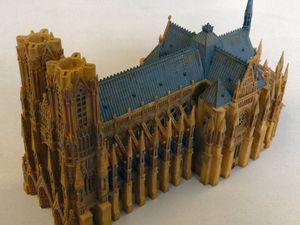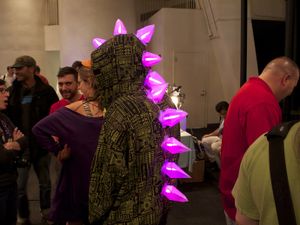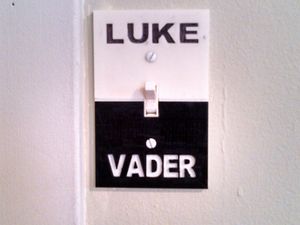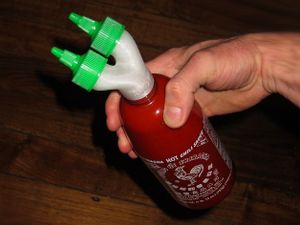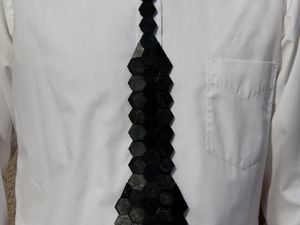User:Nhp5023/Class Blog
Main | About Me | Class Blog
Weekly blog posts on topics stemming from 3D printing.
Contents
Blog 1
A) Something Amazing/Beautiful
The Relms Cathedral Kltset is a beautiful 3D printed piece of art. According to the description, this kitset consists of 62 printed pieces and all parts are drawn from scratch referencing other sources. I personally think it is simply amazing to see the details produced by the printer. This is a work of art that I would love to show it to the world.
B) Something Funny or Strange
Well I thought I have seen it all, unfortunately I have not. I had a good laugh when I first saw the Stegoasuarus Dinosaur Costume Spikes – LED Halloween. Having this for Halloween at State College would be amazing! I would love to be a dinosaur for Halloween! The spikes that were printed looked really detailed and each has a unique look to it.
C) Something Useless
Although the idea of the Wall Switch Plate is meant to be funny with converting to darkness will save you money by switching off the lights, I just don’t see any useful ideas behind it. It’s a comedic printed piece, and means nothing more. If you are not a Star Wars fan, I think you’ll just think that this is just weird or just won’t pay attention to it.
D) Something Useful
I love Sriracha hot sauce and this little object (Dual Chili Extruder) has just made me love the sauce even more. Double the nozzle means double the amount of sauce output! Plus, you can use it to put sauce on two hot dogs!
E) Something Surprising
I did not know that you can make a tie out of 3D printed parts. This is a really cool and innovative design of a hex shaped tie. There are lots of parts that have to be put together, but in the end, you get a flexible plastic tie!
Blog 2: Open Source Ecology (OSE) Project
A) General Impressions of the Open Source Ecology (OSE) Project
The video demonstrated the greater possibility of modular technology. The fact that a tractor can be built within a couple of hours seemed to be too good to be true. Nevertheless, it is true and the project itself is showing noticeable growth regarding the expansion of the ideas and community. The greatest impact regarding the project would be leaning toward third-world and developing countries. Such development would provide the developing areas with opportunities to grow economically and so the people would benefit in the process. However, with such freedom regarding the constructions and the affordable prices, agricultural companies (i.e. John Deere) would most likely be in opposition to the project as it has a great chance of affecting the market of their agricultural products.
Further research has shown great progression in developing the toolkit for agricultural machines. In fact, OSE has a development wiki that contains the first civilization starter kit, which contains open source manuals for some of the prototypes that the groups have designed. For instance, there is an 89 pages guide on how to make the 2011 version CEB Press [1]. If I have genuine interests and resources, I will certainly make an attempt at building one of these machines.
I personally would love to see this come to fruition. As the saying goes, there are many possible solutions for a particular problem.
B) New Yorker Magazine and Marcin Response
The author of the article “The Civilization Kit” [2], Emily Eakin, wrote a critical piece on Marcin Jakubwski’s ideology on self-sufficient industrial/agricultural machines. Moreover, she rather focused on ridiculing his daily lifestyle than that of his ideology and accomplishments. His early routine of doing yoga and meditation for two hours should not be main concerns, but apparently it does matter according to Emily Eakin. She does mention an interesting point regarding the supporters of the project though. She stated that “the people who show up at his farm typically display more enthusiasm for [Marcin’s] ideas than expertise with a lathe or a band saw.” I agree with it to a certain extent as enthusiasm can only go so far. Skillful supporters are what Marcin needs to bring the project further.
Marcin’s response [3] to the article is considerably professional. He cleared up confusions about certain topics regarding the project such as funding, development and goals. He also used this opportunity to defense his points. I am a little confused on his definition of an average person to rise to the occasion in his “Big Hairy Audacious Goal” section. What does he considered as average? An average person with interests, but no skills cannot just go out and build his or herself a tractor. Perhaps he meant an average person with similar academic and machining skills as him. However, an average outside observer will not consider such case. This project is not an individual, but a team effort.
C) PSU OSE Club Possibilities
Although administration or trustees would not support such a thing, I believe there are professors within the Penn State community that are interests and willing to give the idea a try. Since this involves agricultural development, the first group of people I would go to would exist within the agricultural engineering department. I believe that there will be professors within the agricultural fields that would be interests in learning more about the modular technology that the project possesses. Thus, further research would be conducted within the interests of the professors. Furthermore, even manufacturing engineering could relate to what the project is aiming for. Nevertheless, funding could be a big problem. Only through the generation of interests by the majority of the community (i.e. students, faculty, etc.) would spark the possibility of starting something such as the OSE at Penn State.
Blog 3: 3-D Printed RoboHand
A) Who created this design and when/where was it done?
The article talks about a teenager from Kansas, named Mason Wilde, who 3-D printed a robot hand for his family friend’s young son named Matthew. The young kid was born with a condition called “limb difference”, which causes him to have no fingers on his right arm. Mason decided to take on the project after suffering from a concussion from playing football. The mechanical arm costs him roughly 60$ worth of materials and 8 hours of printing time. The idea of the robotic hand was started by Van As when he lost a finger in an accident. He then got in contact with a theatrical artist named Owen who specializes in making puppet mechanical limbs. The first metal prototype was made in November 2012. It was made for a son of a South Africa woman. Then in January 2013, they created the first 3-D printer version and the instructions were put up online for free.
B) If you wanted to make one, where would you go to get it?
I would go to the Thingiverse website [4] to get more information on how to make one. The page contains different designs and also CAD (.stl) files for one to download and 3-D print. Of course, I would need access to a 3-D printer.
C) How many news articles can you find which reference this technology?
USA Today [5] The Wall Street Journal [6] PC Magazine [7] NBC News [8] MakerBot [9]
Blog 4: Response to Teammates' and Classmates' Blogs (Blog #2)
Response to Teammates' Blogs
My teammate Jarred brought up a good point regarding the fact that such modular technology will make the lives of third world citizens easier. I also agree with his astounding reaction to the potential of the project in the future. Nevertheless, Anthony made a reasonable argument as he pointed out that the "civilization starter kit" is a bit misleading in terms of building the machines within a short amount of time. The people that are involved within the project might not have considered all the possible time they have spent on making the machines. Another great point that Anthony made involves the inefficiency of starting from scratch. Such idea is good for developing countries, but it will certainly be really inefficient within developed countries like Japan and the United States. Eva also agrees that the project is wonderful. She mentioned that with more advertisements, the project could become a lot more bigger. I somewhat agree with this statement. My teammate Wenxin also thinks that the project has great potential.
Response to Classmates' Blogs
Drew made a fair point in questioning the effectiveness of the project when it comes to the "one day goal" objective. The team seek to build a functional machine within a day. This is feasible for the people with designing and machining skills, but to those "average" people that are partaking in the project without machining and designing background, it is not reasonable to think that they will be able to accomplish such one day goal.
Kevin made an interesting point regarding starting a similar project at Penn State. He mentioned that it could peak some interests, but at the end of the day, the project is not practical as there is not a great need for it within the region.
My classmate Dongao is skeptical about the project, which I find interesting. He made a decent point regarding the safety issue of the machine production. It could be dangerous for the team if something were to go wrong during the production process. We are dealing with big machines, and not just a small 3-D printer. It is a different ball game regarding the risks of dealing with it.
It is refreshing to hear from a first hand experience about small scale farmers. Nate's family actually runs a small farm here in PA and he mentioned that it is considerably expensive to buy new equipment. His uncle, who is a farmer, actually bought old equipment (from the 1950's) which in need of frequent maintenance and fixes. So he feels that this project has great potential for small scale farmers.
Sam actually made a great point regarding the unnecessary critique from Emily Eakin's article. He made a great point in saying that Emily could not connect with the team leader and that is why she did not show much enthusiastic toward the project. It was also surprising to find out that she is married to a professor at a prestigious college. Her life is different than that of Marcin's, and her article was perhaps somewhat bias due to this circumstance.
Blog 5: RepRap Media Timeline
1.) An event very important in the progression of 3D printing technology (open source or not)
Although the article [10] was very short and didn’t provide much details. It is an important event in the progression of 3D printing technology as a company called Organovo actually managed to 3D printed a liver which can live for 40 days. The company managed to increase the liver survival time from 5 to 40 days just after 4 months of tinkering around with the technology. It is yet to be perfect as they need to implement a way to incorporate blood vessels. Nevertheless, if one were to think about the potential of such implementation in the future, there will be endless possibilities regarding 3D printed organs! Imagine not having to wait for organs from other people, but 3D printed organs that has no chance of rejecting by your body.
2.) A not so important event in the progression of this technology (something overhyped perhaps?)
There was an article that was released on June 15th, 2012 [11] discussing about the revolutionized 3D-printing for guitar-making. From what it stated from the article, 3D printing is used to create guitar bodies. The professor named Olaf Diegel from New Zealand, used EOS 3D printer for printing parts. Personally, I did not think this is revolutionizing the 3D printing technology. The article seemed to have overhyped it. The only thing that Diegel could do with the guitar-making process is to make the body of the guitar. The other guitar parts, such as the headstock, neck, strings, frets, pickups, etc. are all traditionally made. Thus I would consider this to be a not so important event in the progression of 3D printing technology.
3.) Something which you found interesting which you would like to think or speak more about. This might overlap with #1 a bit, depending.
Something which I found interesting and would like to further discuss about occurs on July 26th, 2012 [12]. On this day, the first 3D-printed gun was announced. The printed gun was a .22-caliber pistol that had fired 200 rounds without signs of cracking and breaking. The main body of the gun is 3D printed using normal plastic resin, but the chamber is actually made out of metal. The 3D printer was used to create the lower receiver of the gun, in which is the part that is considered to be “legally-controlled”. Such news must have seemed a bit of a shock for some people out there considering the fact that people now have the potential just print out guns without licenses. If one were to consider the date that the article got released and how far 3D-printing has evolved since then, it is scary to think how much more advance with such idea of personalize gun printing could be.
Blog 3: 3-D Printed RoboHand
Alexandre presented a lot of interesting projects and made me more aware of the possibilities regarding 3D printing. Projects similar to those like OSE kick-starter, and the prosthetic hand advancement enable me to realize the fast evolution of 3D printing technology. Such development has touched a lot of different branches within manufacturing processes. It has got to the point where 3D printing food is now possible. Although it is still fresh, new, and further research is currently conducted around the world to advance the process, I believe this is where the class could possible pursue in terms of focusing on new projects. With the class getting better at fixing and maintaining the current printers, I believe that pursuing 3D printing research is perhaps a good idea. My teammate Anthony is also interested in this topic and we are planning on working together to learn more about 3D printing food and keep the RepRap page updated with newest findings and progress. We could even pursue to make our own 3D food printer. I doubt getting enough people to be interested in this project would be hard to do since at the end of the day, we will get to taste what’s being printed. I love food, so perhaps it could just be a personal thing.
Another idea could be focusing on like an outreach program for other schools around the world. Developing countries like Africa and Vietnam could perhaps be interested in 3D printing technology.
There are questions to be raised in regards to making a composite printer. I’m not knowledgeable with this type of 3D printing, but what will be price to make such a printer? Would composite material costs more to print? If the class just focus on building just one or a few initially, it In the case of dual extruders, I have yet it see it in action but I believe it will be a better transition to go with in terms of pursuing new projects for the class.
